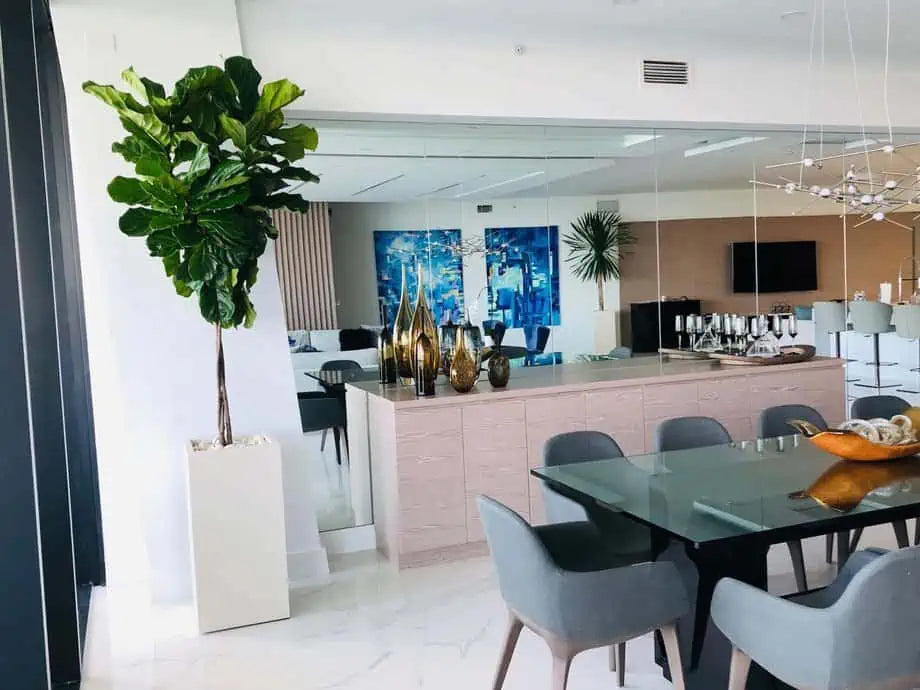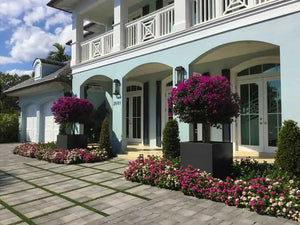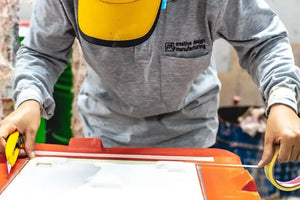When you're a novice gardener, there's a likelihood that nothing scares you more in the container gardening realm than growing trees. The idea of it alone is enough to make your green thumb wither and die, due to the preconceived notion many have that one, container friendly trees don't exist, two, trees are slow growing and you won't see any results for years, and three, how are you supposed to know what trees to grow in the first place?
It's a shame that this is the common thought process around container growing trees. However, in hopes of setting you on a path to understanding trees grown in pots, let's take a deep dive into small trees for pots. This will give you the know how for all your small tree related questions so you can create year round interest at home or in a commercial space!
In this article, we'll focus on small trees for pots. First, we'll discuss the benefits of growing small trees in pots, before moving on to what small trees are suitable for growing. Finally, we'll end the post with some small tree FAQs.
This post will serve as a good starting point for understanding how and what trees to grow. With this knowledge, you'll be able to move onto larger trees and at that point, there's nothing in gardening that can ever scare you away!
Top tip: Whether you're planting trees indoor or outdoor, fiberglass planters are the best option due to numerous benefits that they offer!
What Are The Benefits Of Potted Trees?
To begin, let's take a look at some of the benefits of having trees to grow both indoors and outdoors, whether in a residential or commercial area. Understanding what makes container grown trees so great will be the perfect lead in to finding out the actual trees to grow!
Aesthetics

Perhaps the most obvious benefit of growing trees, even if they're considered smaller trees, is their aesthetic appeal as a result of their size. It's easy to see why this is the case. Just think, if you have two plants sitting side by side, one which is a dainty collection of white flowers, and the second which is something like the Japanese Maple, which do you think will stand out the most?
Without trying to diminish the beauty of white flowers--or any color flowers, for that matter--pot trees just possess more of a natural oomph as a result of their size. It's like comparing an NBA star to an Olympic gymnast: one isn't better than the other, they're just different!
Furthermore, container grown plants allow you to grow plants indoors that you might not otherwise be able to. If you're a homeowner or interior designer looking to bring an Olive Tree, Evergreen Tree, or Pine Trees indoors, you can do that if they're inside a planter box!
Why not try a Saigon Round Tapered Planter for this?
Functionality

Trees are great not only for their form but their functionality, too! As opposed to smaller plants which mainly have decorative purposes, trees fulfill other objectives on top of their magnificent visual appeal. What are some of these functions? Let's find out!
For starters, have you ever thought about the fact that most trees will give you a certain amount of shade and privacy? Regardless of if they're a small tree, their size naturally allows for a privacy screen to be built around any given area, while also providing a decent amount of shade. This is great in homes if you want to block off the view from neighbors, and it's also useful in a commercial space like a restaurant--Outdoor seating is never more enjoyable than when it's just you, your friends, and your meal!
On the other hand, some trees like Olive Trees and Fruit Trees (Banana Trees, Peach Trees, Citrus Trees...) will literally bear food for you to pick and eat--If that isn't functional then I don't know what is! Such trees will then provide aesthetic appeal, privacy, shade, and sustenance depending on their growing season. How could you ask for more?
Flexibility
Another standout benefit container grown trees have, this time in contrast with trees grown in the ground, is the fact of their flexibility. But what do we mean by flexibility? Obviously, this isn't to say container trees can do the splits while ones grown in the dirt can't--No.
What we mean by this is that once you plant a tree in the ground, you pretty much have to accept the fact that it will remain in the same spot you first planted it. If you happen to plant it in the wrong spot, you can either risk killing it by removing the roots or just accept where it is--Now how do you like the sound of that?

In contrast, trees inside a planter box benefit from the fact that they can be moved around because they're inside a container. Each container grown tree is a self-supporting system in and of itself meaning you can transport it around a location based on its requirements and your individual tastes.
Is it drought tolerant? Not all trees are but with container planting, you can simply move it indoors and give it more water. Is the late winter cold withering its leaves? Again, moving it inside might fix that.
Got outdoor space for an outdoor garden? Check out these ideas for the best patio planters!
10 Best Small Tree Ideas For Beautiful Potted Trees!
Now you know about the benefits of trees, let's take a look at some ideas for actual trees to grow. These ideas will help you introduce trees in pots anywhere you'd like, something that, according to a study in 2018, is a great way to mitigate the stress levels one might feel from being in an overly urban environment!
1. Japanese Maple
One of the most popular trees to grow, the Japanese Maple comes in so many varieties it'd be impossible not to find the one that's right for you.
As a whole, Japanese Maples are deciduous, flowering trees, with spectacular fall foliage that turns shades of red, orange, yellow, purple, and green, depending on the type. Perfect for growth in a backyard or garden, the dwarf varieties allow you to get the best of both worlds: stunning color without the hassle of a massive plant. However, the size is entirely up to you. Larger Japanese Maples will grow to heights between 20ft - 30ft, whereas the dwarf varieties are capped from 4ft - 8ft.

For the purpose of this post, you'd be better off going with the smaller deciduous trees. These will still provide the desired amount of shade and privacy to any space, while also providing the mesmeric look characteristic of a beautiful tree.
To grow and care for a Japanese Maple, have the container tree in a spot that receives either full sun or partial shade. The potting soil should be filled in a large container with good drainage, just make sure it's kept at a relatively moist level--There you've got it, the recipe for your own beautiful Japanese Maple!
A Montroy Cube Planter, which comes in 11 sizes, could be the perfect container for this!
Best Small Fruit Trees For Pots
As mentioned, planting trees in pots is great because they serve as much of a functional purpose as an aesthetic one. This is never more the case than with fruit trees, which tick those boxes by providing actual food for you to eat, as well as giving your home or patio restaurant a quaint backdrop reminiscent of country towns in the Mediterranean. But before you go buying as many Fruit Trees as you can find, let's take a look at some of the most popular varieties.
2. Citrus Trees

Perhaps containing the most selection of Fruit Trees, Citrus Trees most commonly refer to grapefruit, orange, lime, and lemon trees. As you might imagine, these are the best trees to grow in warmer climates, with the full sun and healthy amounts of water providing the right amount of nourishment for them to really blossom. If you do happen to live in a cooler area, you can still grow something like a lemon tree by potting it in a large container with well-draining soil. How about a Globe Planter for this?
3. Peach Tree

When grown from a seedling, the peach tree is one of the slowest growing, taking at least three or four years before it bears any ripe peaches. To get over this, consider a small tree planted in a container to jump start the process. Trees planted in the late winter or early summer will be the best as they have a growing season to develop. At that point, all you really need to do is keep it in the full sun while providing adequate water and it won't be long before you've got ripe peaches to be turned into jams, jellies, or juices!
4. Olive Tree

Though one might argue whether an Olive Tree can be considered a fruit tree, we'll include them on this list as they still bear fruit. One of the oldest cultivated trees in the world, young Olive Trees are the perfect trees to grow if you want to introduce an ancient Greek ambiance to any indoor or outdoor space--Is there anything more chic than the past?
To get started, try to grow young Olive Trees in spots that get dry, hot weather. If this is impossible, having dwarf varieties of the Olive tree in a large container will allow you to bring it inside when temperatures drop. Though slow growing (about 1 - 2 ft per year), your patience will pay dividends when you finally harvest your homegrown olives--They can be eaten on their own, added to a pasta dish like a Puttanesca, or turned into your own special olive oil!
What's the best material for a planter? Read up on these 5 fiberglass planter benefits!
5. Bay Trees

In a way similar to Fruit Trees, Bay Trees are a great option for container grown trees because of the wonderful aroma they provide.
The most popular Bay Trees to grow are the Sweet Bay Tree and the Bay Laurel Tree. Both are classified as Evergreen Trees, but the latter is the one most known for its leaves which can be used in cooking--That's right, bay leaves! Other Bay Trees are similar in that they have the typical glossy, oblong leaves, but those can also sometimes have an aroma that is much too overpowering.
In any case, whether you decide to use Bay Trees for cooking or just for show, care for these slow growing Evergreen Trees is relatively simple. Whether growing indoors or outdoors, make sure they get full sun or partial shade and prune them periodically to ensure they stay at your desired height. Fully-grown Bay Trees can reach up to 60 ft tall, but again, this will take a while so you need not worry.
Got your tree but worried about pot maintenance? Read up on fiberglass planter maintenance to get started!
Honorable Mentions
- Cypress Trees (Italian Cypress)
- Palm Trees
- Evergreen Conifers
- Crepe Myrtle
- Weeping Fig
Top tip: These plants will look beautifully as a focal point in a round planter!
Potted Tree FAQs!

How Do You Plant Small Trees For Pots?
When starting to plant small trees, choose a large container. On top of this, Robin Horton, writer for Urban Gardens recommends choosing frost-proof and UV-resistant pots at least twice the width and depth of the root ball. Fiberglass planters are a great starting option to meet all these requirements.
Once that's sorted, fill the container with potting mix from your local garden center and then pack the roots of the tree to grow inside. It's as simple as that!
How Do You Water A Potted Tree?
You water a potted tree pretty much the same as you do one growing in the ground. The only real difference is the fact that a potted tree will likely require more watering. Ensuring you understand the requirements of your individual plant, water frequently so the soil stays moist--Just don't go overboard!
Can Potted Trees Survive Over Winter?
Really, this depends on the individual tree.
However, what makes a potted tree so great in comparison to one growing in the ground, is the fact that you can easily transport it inside when you need to - Like we said, it is flexible!
What this means is that even if your specific tree can't handle harsher weather climates, whether that be the cold or the heat, you can always change its environment to ensure it stays alive.
What Are Pruning and Mulching?
You might have encountered these terms when beginning to look for your personal potted tree. But what do they mean? Let's find out!
Pruning refers to the removal of certain components of a plant to ensure it continues to grow healthily. This might mean removing bare branches, and buds, or there's even a type of pruning called root pruning!
On the other hand, mulching is a term to define the act of adding material such as fresh compost, cardboard, manure, and the like to the surface layer of soil. What this does is it allows the soil to retain its moisture, ensuring overall health and fertility.
Want to know how to install a planter? Check out this guide on installing fiberglass planters!
JBD Concepts Offer You The Best Planters For Small Potted Trees!

Now you have a few ideas for potted trees, why not take a look at some planters that can help you build your very own tree-filled oasis? JBD Concepts planters come with an industry-leading warranty for both residential and commercial use giving you peace of mind that your investment is safe, and that the form, function, and beauty of your new planter will last for as long as you need.
Are you a homeowner, landscape architect, or interior designer? If you want to get more customers with our planters, contact us today to learn more about the exciting opportunities our wholesale range offers!
All our planters are available for retail customers too. Simply visit our store, select your planters, size, and finish and enjoy incredible value at affordable prices!
Shop now and begin improving your space!










